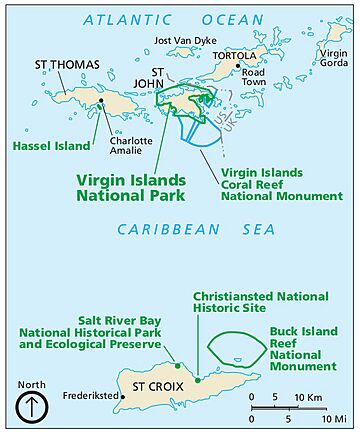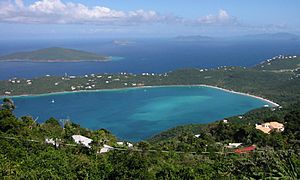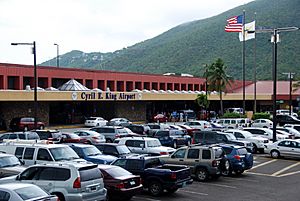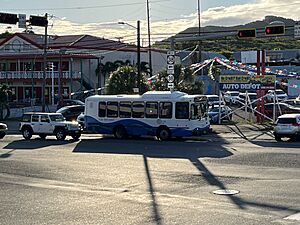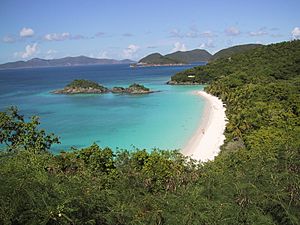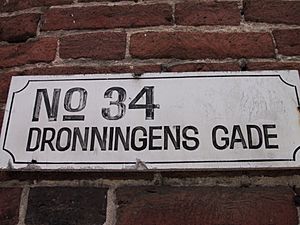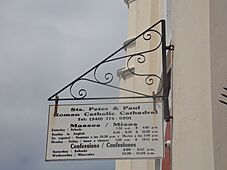United States Virgin Islands facts for kids
Quick facts for kids
Virgin Islands of the United States
|
|||
|---|---|---|---|
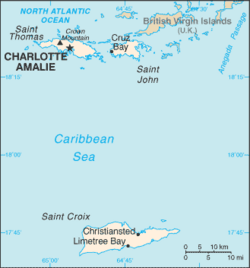
Map of the U.S. Virgin Islands
|
|||
|
|||
| Motto(s):
"United in Pride and Hope"
|
|||
| Anthem: "Virgin Islands March" |
|||
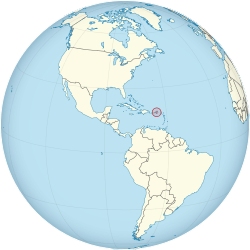
Location of the United States Virgin Islands
|
|||
| Country | |||
| Before purchase | Danish West Indies | ||
| Transfer from Denmark | March 31, 1917 | ||
| Capital and largest city
|
Charlotte Amalie 18°21′N 64°56′W / 18.350°N 64.933°W |
||
| Official languages | English | ||
| Ethnic groups
(2020)
|
By ethnicity
|
||
| Religion
(2022)
|
|
||
| Demonym(s) | Virgin Islander; U.S. Virgin Islander | ||
| Government | Devolved presidential constitutional dependency | ||
| Joe Biden (D) | |||
|
• Governor
|
Albert Bryan (D) | ||
| Tregenza Roach (D) | |||
| Legislature | Legislature of the Virgin Islands | ||
| Area | |||
|
• Total
|
346.4 km2 (133.7 sq mi) (168th) | ||
|
• Water (%)
|
negligible | ||
| Highest elevation | 474 m (1,555 ft) | ||
| Population | |||
|
• 2020 census
|
87,146 | ||
|
• Density
|
653.6/sq mi (252.4/km2) | ||
| GDP (PPP) | 2019 estimate | ||
|
• Per capita
|
$38,136 | ||
| GDP (nominal) | 2019 estimate | ||
|
• Total
|
US$4.068 billion | ||
| HDI (2019) | very high · 31st |
||
| Currency | United States dollar (US$) (USD) | ||
| Time zone | UTC−4:00 (AST) | ||
| Date format | mm/dd/yyyy | ||
| Driving side | left | ||
| Calling code | +1–340 | ||
| USPS abbreviation |
VI
|
||
| Trad. abbreviation |
U.S.V.I.
|
||
| ISO 3166 code |
|
||
| Internet TLD | .vi | ||
The United States Virgin Islands, also known as the U.S. Virgin Islands, are a group of Caribbean islands. They are an unincorporated and organized territory of the United States. These islands are part of the larger Virgin Islands archipelago and are located in the Leeward Islands of the Lesser Antilles.
The U.S. Virgin Islands include the main islands of Saint Croix, Saint John, and Saint Thomas. There are also about 50 smaller islands and cays around them. The total land area is about 346 square kilometers (133.73 square miles). The capital city is Charlotte Amalie, which is on the island of St. Thomas.
Before becoming a U.S. territory, these islands were known as the Danish West Indies. They belonged to Denmark–Norway and later to Denmark. In 1917, Denmark sold the islands to the United States for $25 million. This event is remembered every year on Transfer Day. Since then, the U.S. Virgin Islands have been an organized, unincorporated territory of the United States. Like other U.S. territories, the Virgin Islands elect a delegate. This delegate can speak in the U.S. House of Representatives but cannot vote on laws.
Tourism is the most important part of the islands' economy.
Contents
- Island Names: How They Got Their Names
- Island History: A Journey Through Time
- Island Geography: Where Are They?
- Island Economy: How People Make a Living
- Island Travel and Communication
- Island People: Demographics
- Island Culture: Traditions and Arts
- Island Sports: Fun and Games
- Notable People from the Islands
- Images for kids
- See also
Island Names: How They Got Their Names
The islands were named Santa Úrsula y las Once Mil Vírgenes by Christopher Columbus in 1493. He named them after a legend about Saint Ursula and 11,000 virgins. Later, the name was shortened to simply the Virgin Islands.
Island History: A Journey Through Time
Early People and European Arrivals
The first people to live on the U.S. Virgin Islands were the Ciboney and Arawaks. Some experts believe people lived here as early as 1000 BC. The Kalinago (Island Caribs) arrived around the mid-1400s AD.
In 1493, Christopher Columbus was likely the first European to see the islands. He gave them their current name. Spanish settlers arrived in 1555. English and French settlers came to St. Croix starting in 1625. For a long time, different European countries like Spain, France, Britain, and the Netherlands argued over who owned the islands.
Danish Rule and Changes
Denmark–Norway became interested in the islands. The Danish West India Company settled on St. Thomas in 1672 and St. John in 1694. They later bought St. Croix from France in 1733. In 1754, the islands became royal Danish colonies. They were called the Danish West Indian Islands.
The islands were perfect for growing sugar. Sugarcane, grown by enslaved Africans, was the main driver of the islands' economy in the 1700s and early 1800s. Other crops included cotton and indigo dye. A large Jewish community also began to settle on the islands during this time.
In 1733, St. John saw one of the first major slave rebellions in the New World. Enslaved Africans from the Gold Coast (modern Ghana) took control of the island for six months. The Danish, with help from the French, eventually defeated them.
After another slave rebellion on St. Croix, slavery was ended by Governor Peter von Scholten on July 3, 1848. This day is now celebrated as Emancipation Day. After slavery ended, the sugar plantations became less profitable. Danish settlers started leaving, which caused the population and economy to decline. Natural disasters like a hurricane and an earthquake in 1867 also hurt the economy.
Denmark tried to sell the islands to the United States in 1867, but the deal didn't happen. By the time World War I started, the islands were not doing well financially for Denmark. The United States became worried that Germany might try to take the islands during the war. So, the U.S. asked Denmark again about buying them.
After several months of talks, they agreed on a price of $25 million in U.S. gold coins. The Treaty of the Danish West Indies was signed on August 4, 1916. Voters in Denmark approved the sale in a special vote. The deal was completed on January 17, 1917.
Becoming a U.S. Territory
The United States officially took control of the islands on March 31, 1917. The territory was renamed the Virgin Islands of the United States. Every year, Transfer Day is a holiday to remember this event. Rear Admiral James H. Oliver was the first American governor.
Many people living on the islands became U.S. citizens in 1927 and 1932. The U.S. dollar became the currency in 1934. After World War II, tourism started to grow and became very important to the islands' economy. The Virgin Islands National Park was created on St. John in 1956. By 1959, the U.S. Virgin Islands became a popular place for tourists. In 1970, Virgin Islanders elected their first governor.
Water Island, a small island near St. Thomas, became part of the U.S. Virgin Islands territory in 1996.
An oil refinery, the Hovensa plant, was built on St. Croix in 1966. It was one of the world's largest oil refineries for a long time. It closed in 2012, which caused a big economic problem for the islands.
The U.S. Virgin Islands have been hit by several strong hurricanes. Hurricane Hugo in 1989 and Hurricane Marilyn in 1995 caused a lot of damage. In September 2017, Category 5 Hurricane Irma hit St. John and St. Thomas very hard. Just two weeks later, Category 5 Hurricane Maria caused widespread damage across all three main islands. These hurricanes destroyed many buildings and caused power outages.
Island Geography: Where Are They?
The U.S. Virgin Islands are in the Atlantic Ocean. They are about 64 kilometers (40 miles) east of Puerto Rico. They are also right next to the British Virgin Islands. They share the Virgin Islands group with the Puerto Rican Virgin Islands (Vieques and Culebra).
The territory has three main islands: St. Thomas, St. John, and St. Croix. There are also many smaller islands. Locals often have nicknames for the main islands: St. Croix is "Twin City," St. Thomas is "Rock City," and St. John is "Love City." The total land area is about twice the size of Washington, D.C..
The U.S. Virgin Islands are famous for their white sand beaches, like Magens Bay and Trunk Bay. They also have deep harbors along the Anegada Passage, including Charlotte Amalie (the capital). Most of the islands, like St. Thomas and St. John, were formed by volcanoes and are hilly. The highest point is Crown Mountain on St. Thomas, which is 474 meters (1,555 feet) high.
St. Croix is the largest of the U.S. Virgin Islands. It is flatter because it was formed from coral. The National Park Service manages more than half of St. John. They also manage almost all of Hassel Island and many acres of coral reef.
There are several national park sites, such as the Virgin Islands National Park and the Buck Island Reef National Monument.
The U.S. Virgin Islands are located where the North American plate and the Caribbean Plate meet. This means they can experience earthquakes, hurricanes, and tsunamis.
Island Climate: Sunny and Warm
The United States Virgin Islands have a tropical climate. This means there isn't much change in seasons throughout the year. Most of the rain falls from May to October. In the winter, steady winds called northeast trade winds blow. Summer and winter temperatures are usually very similar.
| Climate data for St. Thomas, Virgin Islands | |||||||||||||
|---|---|---|---|---|---|---|---|---|---|---|---|---|---|
| Month | Jan | Feb | Mar | Apr | May | Jun | Jul | Aug | Sep | Oct | Nov | Dec | Year |
| Record high °F (°C) | 93 (34) |
93 (34) |
94 (34) |
96 (36) |
97 (36) |
99 (37) |
98 (37) |
99 (37) |
98 (37) |
97 (36) |
95 (35) |
92 (33) |
99 (37) |
| Mean daily maximum °F (°C) | 85 (29) |
85 (29) |
86 (30) |
87 (31) |
88 (31) |
89 (32) |
90 (32) |
90 (32) |
90 (32) |
89 (32) |
87 (31) |
86 (30) |
88 (31) |
| Mean daily minimum °F (°C) | 72 (22) |
73 (23) |
73 (23) |
74 (23) |
76 (24) |
78 (26) |
78 (26) |
78 (26) |
78 (26) |
77 (25) |
75 (24) |
74 (23) |
76 (24) |
| Record low °F (°C) | 63 (17) |
62 (17) |
56 (13) |
62 (17) |
66 (19) |
67 (19) |
57 (14) |
59 (15) |
64 (18) |
66 (19) |
52 (11) |
62 (17) |
52 (11) |
| Average precipitation inches (mm) | 2.38 (60) |
1.48 (38) |
1.42 (36) |
2.74 (70) |
3.06 (78) |
2.53 (64) |
2.85 (72) |
3.74 (95) |
5.58 (142) |
5.42 (138) |
5.23 (133) |
2.96 (75) |
39.39 (1,001) |
| Source: weather.com | |||||||||||||
Island Animals: What Lives Here?
Island Economy: How People Make a Living
Tourism is the biggest industry in the U.S. Virgin Islands. About 2.5 to 3 million people visit each year. This sector makes up about 60% of the islands' total economic activity. Other important parts of the economy include government jobs, some farming, and small-scale manufacturing, especially making rum.
In 2012, businesses on the islands made $6.8 billion in sales and employed over 32,000 people. However, sales dropped a lot between 2007 and 2012.
The unemployment rate was 11.5% in the first half of 2016. Many jobs are in the "leisure and hospitality sector," which includes hotels, restaurants, and entertainment for tourists.
Farming is a small part of the economy. Most food has to be imported. There are also some manufacturing jobs and construction jobs. The government is the largest employer on the islands.
The islands have faced financial challenges. In 2012, the HOVENSA oil refinery, which was the largest private employer, closed. This had a big negative impact on the economy. The islands also have a high amount of debt. To help with money problems, the government introduced new or increased taxes on things like rum, beer, and sugary drinks in 2017.
Tourism: A Major Industry
Tourism, trade, and other service industries are the main ways people make money. They account for almost 60% of the islands' economy. Most tourists arrive on cruise ships. Even though these visitors don't spend a huge amount individually, together they contribute hundreds of millions of dollars to the economy. Over half of the workers on the islands are employed in jobs related to tourism.
The islands are also a popular starting point for private yacht charters to the nearby British Virgin Islands.
Other Ways People Earn Money
The manufacturing sector mainly involves rum distilling. The farming sector is small, so most food is imported. International business and financial services are growing. Most of the islands' energy comes from imported oil, which makes electricity very expensive. The Virgin Islands Water and Power Authority also uses imported energy to make fresh water from the ocean.
Taxes and Trade
The U.S. Virgin Islands have their own customs territory, separate from the U.S. mainland. This means they act like a free port. U.S. citizens don't need to go through customs when arriving from the mainland, but they do when traveling back to the mainland. People who live in the U.S. Virgin Islands do not pay U.S. federal income taxes on money earned there. Instead, they pay taxes to the territory, similar to what federal taxes would be.
Island Travel and Communication
There are two main airports: the Henry E. Rohlsen International Airport on St. Croix and the Cyril E. King Airport on St. Thomas.
The U.S. Virgin Islands is the only U.S. place where people drive on the left side of the road. This tradition comes from when the islands were owned by Denmark. However, most cars are imported from the U.S. mainland, so they have the steering wheel on the left side.
The VITRAN (Virgin Island Public Transit) system provides public transportation. It includes buses, special services, and ferries that connect towns, tourist spots, and islands.
Mail service is handled by the United States Postal Service. The postal code for the islands starts with 008xx. The islands are part of the North American Numbering Plan, using area code 340. This means people can call most toll-free U.S. numbers.
The U.S. Virgin Islands are in the Atlantic Standard Time zone. They do not use daylight saving time. This means they are one hour ahead of Eastern Standard Time when the mainland U.S. is on standard time. When the mainland U.S. is on daylight saving time, the time is the same.
Island People: Demographics
| Historical population | |||
|---|---|---|---|
| Census | Pop. | %± | |
| 1970 | 62,468 | — | |
| 1980 | 96,569 | 54.6% | |
| 1990 | 101,809 | 5.4% | |
| 2000 | 108,612 | 6.7% | |
| 2010 | 106,405 | −2.0% | |
| 2020 | 87,146 | −18.1% | |
| Sources: | |||
In 2020, the population of the U.S. Virgin Islands was 87,146. This was a decrease from 2010.
In 2020, about 24.1% of households had children under 18. The average household size was 2.14 people. The median age of the population was 33 years old. The literacy rate for adults was 94.9% in 2010.
Ethnic Groups: A Mix of Cultures
The racial makeup of the U.S. Virgin Islands in 2020 was:
- Black or Afro-Caribbean: 71.4%
- Hispanic or Latino (any race): 17.4% (including Puerto Rican and Dominican)
- White: 16.6%
- Mixed: 7.4%
- Asian or Asian Caribbean: 1.0%
- Other: 3.6%
Many residents have family roots in other Caribbean islands, especially Puerto Rico. Most people on the islands have Afro-Caribbean backgrounds.
Languages: English and More
English is the main language spoken. As of 2010, Spanish is spoken by 17.2% of the population aged five and older. French or French Creole is spoken by 8.6%.
English has been the main language since 1917, when the islands became part of the United States. When Denmark owned the islands, Danish was the official language. However, it was mostly spoken by Danish administrators. Many place names and family names still come from Danish.
Even during Danish rule, Dutch was more common on St. Thomas and St. John. On St. Croix, English was the main language. Other languages spoken included Irish, Scots, Spanish, and French.
Virgin Islands Creole English, also called "dialect," is spoken in everyday conversations. The version spoken on St. Croix, called Crucian, is a bit different from what's spoken on St. Thomas and St. John. Because many people from other Caribbean islands have moved to the U.S. Virgin Islands, Spanish and different French Creole languages are also widely spoken. Spanish is mostly spoken by Puerto Ricans on St. Croix. Many Puerto Ricans moved to St. Croix in the 1930s, '40s, and '50s for work. They have kept their culture alive while mixing it with the local Crucian culture.
Negerhollands, a Dutch-based creole language, used to be spoken on St. John, St. Croix, and St. Thomas. The last person who spoke Negerhollands died in 1987, so the language is now gone.
Religion: Many Beliefs
Religion in the United States Virgin Islands (2010) Protestant (65.5%) Catholic (27.1%) Other Christian (1.8%) Unaffiliated (3.7%)
Christianity is the main religion in the U.S. Virgin Islands. In 2010, about 94.8% of the population was Christian. The largest Christian groups were Baptist, Catholic, and Episcopal.
Because of their Danish past and American present, Protestantism has been common for a long time. Lutheranism was brought by the Danish. Other religions like Anglicanism, Catholicism, and the Moravian Church were also allowed. The Moravian missionaries were known for their work on St. Thomas and St. Croix.
There is also a strong Catholic presence. Rastafari is also common. St. Thomas has one of the oldest Jewish communities in the Western Hemisphere. Sephardi Jews started settling there in the 1700s as traders. The St. Thomas Synagogue in Charlotte Amalie is the second-oldest synagogue in the U.S. and the oldest still in use. Hinduism and Islam are practiced by people of Indian descent. There are Hindu temples on St. Croix and St. Thomas. There is also a Buddhist temple on St. Thomas.
Education: Learning on the Islands
The United States Virgin Islands Department of Education is in charge of schools. It has two school districts: St. Thomas-St. John and St. Croix.
The University of the Virgin Islands offers higher education. It has campuses on St. Thomas and St. Croix. Students can earn associate's, bachelor's, master's, and PhD degrees.
Island Culture: Traditions and Arts
The culture of the Virgin Islands shows the mix of people who have lived there. This includes people from West Africa, Europe, and America. Immigrants from the Arab world, India, and other Caribbean islands have also added to the culture. The islands were strongly influenced by the British, Dutch, French, and Danish during the many years they were under these powers.
Island Music
Island Media: News and Entertainment
The islands have many AM and FM radio stations. They play music, religious programs, and news. There are also television stations. Newspapers include:
- The Avis (daily, St. Croix)
- The Virgin Islands Daily News (daily, St. Thomas)
- St. John Tradewinds (weekly, St. John)
There are also several online news sources like St. Thomas Source and The Virgin Islands Consortium.
Island Libraries: Places to Read and Learn
The first public library in the U.S. Virgin Islands opened in St. Thomas in December 1920. The Carnegie Corporation of New York helped fund library services from 1929 to 1933.
Enid M. Baa was an important person for libraries in the Virgin Islands. She was one of the first high school graduates in St. Thomas. She later became the Supervising Librarian for the Virgin Islands, the first woman to hold such a high government position. She also worked to preserve important historical records.
The U.S. Virgin Islands Public Library System currently has five libraries. Three are on St. Croix, and one is on St. John. St. Thomas has two, but one is currently used for administrative purposes. These libraries offer free services for all ages. They have books, magazines, newspapers, and DVDs. They also have historical archives and records. The libraries provide free internet access to the public.
Island Holidays: Days Off to Celebrate
The U.S. Virgin Islands celebrate many public holidays, including:
- January 1: New Year's Day
- January 6: Three Kings Day
- January (third Monday): Martin Luther King Jr. Day
- March 31: Transfer Day (celebrates the islands joining the U.S.)
- July 3: Emancipation Day (celebrates the end of slavery)
- July 4: U.S. Independence Day
- September (first Monday): Labor Day
- October (second Monday): Virgin Islands–Puerto Rico Friendship Day/Columbus Day
- November 1: D. Hamilton Jackson Day (also known as "Liberty Day")
- November 11: Veterans Day
- November (fourth Thursday): Thanksgiving Day
- December 25: Christmas
- December 26: Christmas Second Day (also known as "Boxing Day")
Government workers also get time off for the St. Croix and St. Thomas carnival events.
Island Sports: Fun and Games
Basketball is a very popular sport in the Virgin Islands. Some famous NBA players, like Nicolas Claxton and Hall-of-Famer Tim Duncan, are from the Virgin Islands. Aliyah Boston, a top women's college basketball player, was also born and raised in St. Thomas.
In cricket, people from the Virgin Islands can play for the West Indies cricket team. Hayden Walsh Jr. is a recent Virgin Islander who played for the West Indies.
The U.S. Virgin Islands also have men's and women's national soccer teams.
Notable People from the Islands
- List of people from the United States Virgin Islands
Images for kids
-
Ancient petroglyphs in the Virgin Islands National Park
-
The aftermath of Hurricane Marilyn on the island of St. Thomas, 1995. In recent decades the U.S. Virgin Islands have been devastated by a series of hurricanes.
See also
 In Spanish: Islas Vírgenes de los Estados Unidos para niños
In Spanish: Islas Vírgenes de los Estados Unidos para niños




